

53 Ways to Check for Understanding. How to Humanize Your Online Class. Melding Bloom's Taxonomy and Universal Design for Learning. A MiddleWeb Blog Reflection is a necessary part of all effective teaching and learning.
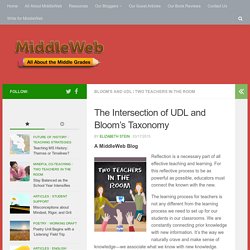
For this reflective process to be as powerful as possible, educators must connect the known with the new. The learning process for teachers is not any different from the learning process we need to set up for our students in our classrooms. We are constantly connecting prior knowledge with new information. It’s the way we naturally crave and make sense of knowledge—we associate what we know with new knowledge. We should never lose sight of validated practices from decades ago that have great potential to strengthen our instruction in our current diverse classrooms. Bloom’s Taxonomy is one those validated best practices that has stood the test of time and our evolving efforts to educate our students.
UDL Universe: Universal Design for Learning Professional Development. CAST: Home. How To Create A Meaningful eLearning Experience: 6 Tips For eLearning Professionals. The more meaningful find the learners an eLearning experience, the better becomes their knowledge retention.
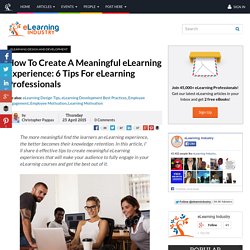
In this article, I' ll share 6 effective tips to create meaningful eLearning experiences that will make your audience to fully engage in your eLearning courses and get the best out of it. Undoubtedly, there is a very common way to learn something: Repeat, repeat, and then repeat some more. But who wants to sit through a monotonous and tiring technique like rote learning, when learners are given the opportunity to deeply understand and quickly memorize a topic by relating it to knowledge already stored in their brains? This is exactly what meaningful eLearning is about: The eLearning process through which new knowledge emerges when a potentially meaningful concept or proposition is related to learners’ previous knowledge, so that they can successfully store it in their long term memory. It sounds ideal for eLearning professionals, doesn’t it?
The Adult Learning Theory - Andragogy - Infographic. Adult Education Infographics The Adult Learning Theory – Andragogy – Infographic The Adult Learning Theory Infographic The Adult Learning Theory – Andragogy – Infographic explores Malcolm Knowles’ Adult Learning Theory, Knowles’ 5 Assumptions of Adult Learners, and the 4 Principles of Andragogy.
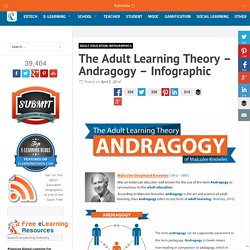
Also, I highly encourage you to read The Adult Learning Theory – Andragogy – of Malcolm Knowles article. You may also find valuable the 9 Tips To Apply Adult Learning Theory to eLearning. Last but not least, I highly encourage you to Join us at the Instructional Design History Journey A New Instructional Design Model Will Be Added Every Week! Via: elearningindustry.com Embed This Education Infographic on your Site or Blog! 3 Tips for Content Curation in Blended Learning. By Nicole Bunselmeyer and Manjit Sekhon Short-form content is an exciting new modality for learners.

For the instructional designers in charge of creating and delivering all those new short-form assets, though, it can be a big new challenge. Here are a few tips for handling content curation in blended learning. 1. Start by Leveraging Existing Content When building a blended learning environment, your first step should be to review what content already exists. So many companies have vast content and knowledge repositories (think Sharepoint sites) that everyone knows about — but, honestly, you probably don’t know exactly what’s in there. Competency-Based Education: A Framework for Measuring Quality Courses. Jackie Krause Central Washington University krausej@cwu.edu Laura Portolese Dias Central Washington University diasl@cwu.edu Chris Schedler Central Washington University schedlerc@cwu.edu Abstract The growth of competency-based education in an online environment requires the development and measurement of quality competency-based courses.
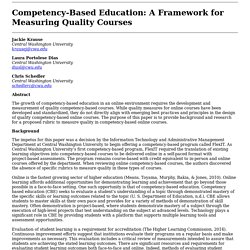
While quality measures for online courses have been developed and standardized, they do not directly align with emerging best practices and principles in the design of quality competency-based online courses. The purpose of this paper is to provide background and research for a proposed rubric to measure quality in competency-based online courses. Background The impetus for this paper was a decision by the Information Technology and Administrative Management Department at Central Washington University to begin offering a competency-based program called FlexIT. Rubrics - More than Just Assessment - OLC. Continuing and Professional Education Program. The Continuing and Professional Education (CPE) Rubric, Second Edition, a research- and best practices-supported tool, guides the design and review of online and blended non-credit courses.
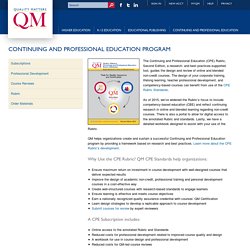
The design of your corporate training, lifelong learning, teacher professional development, and competency-based courses can benefit from use of the CPE Rubric Standards. As of 2015, we’ve widened the Rubric’s focus to include competency-based education (CBE) and reflect continuing research in online and blended learning regarding non-credit courses. There is also a portal to allow for digital access to the annotated Rubric and standards. Lastly, we have a detailed workbook designed to assist with your use of the Rubric. Learning About Learning: How People Really Learn (3 articles) Learning about learning—one of our favorite ‘water cooler’ topics at Intrepid.
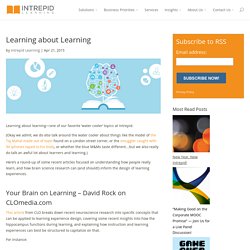
(Okay we admit, we do also talk around the water cooler about things like the model of the Taj Mahal made out of toast found on a London street corner, or the smuggler caught with 94 iphones taped to his body, or whether the blue M&Ms taste different…but we also really do talk an awful lot about learners and learning.) Here’s a round-up of some recent articles focused on understanding how people really learn, and how brain science research can (and should!)
Inform the design of learning experiences. Your Brain on Learning – David Rock on CLOmedia.com. Are you in alignment? - OLC. The Neuroscience Of Storytelling (For Presentations)